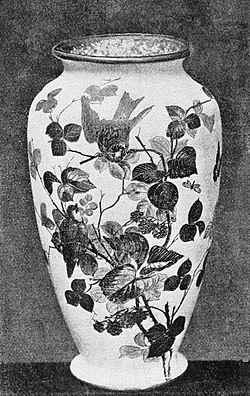they have been making a decorated product in colored bodies, to which they have given the name "Rieti" ware. This is a semi-porcelain, finished and decorated chiefly after the Doulton, Adderley, and Worcester methods. They also make true hard porcelain of an admirable quality, and their goods are characterized by an artistic style of decoration and excellence of glaze, their mazarine blue and "old ivory" finish being especially praiseworthy. The decorating branches are under the direct supervision of Mr. J. W. Phillips, who originates and engraves many of the best designs used in their printing processes. Most of their shapes are utilitarian rather than ornamental, but they have succeeded in imparting to these a grace of outline and delicacy of coloring which render them objects of great beauty. Their chocolate-jugs, jardinières,  Fig. 18.—Semi-porcelain Vase. New England Pottery Company, 1889. and cuspidors compare very favorably with the imported wares, after which they are to some extent patterned. Of the few purely decorative forms which they have attempted, a semi-porcelain vase, twenty inches in height, made in 1880, is particularly meritorious. This is artistically painted in natural colors on raised paste, the top and base being in solid, dead gold. Mr. Bands, of the Royal Worcester Works, England, was the artist.
Fig. 18.—Semi-porcelain Vase. New England Pottery Company, 1889. and cuspidors compare very favorably with the imported wares, after which they are to some extent patterned. Of the few purely decorative forms which they have attempted, a semi-porcelain vase, twenty inches in height, made in 1880, is particularly meritorious. This is artistically painted in natural colors on raised paste, the top and base being in solid, dead gold. Mr. Bands, of the Royal Worcester Works, England, was the artist.
The Ott and Brewer Company, of Trenton, N. J., now operates the factory which was built by Messrs. Bloor, Ott & Booth, in 1863. Mr. J. Hart Brewer, president of the company, entered the firm in 1865, and, being an artist himself of considerable ability, soon made his influence felt in the improvement of methods and elevation of standards. Until 1876 the chief products of this factory consisted of white granite and cream-colored ware. At the Centennial Exhibition the company made a display of a series of artistic Parians which had been designed mainly by Mr. Isaac Broome, an American artist of remarkable versatility and great promise. Of these special pieces,

